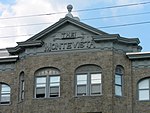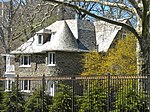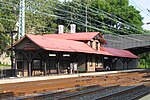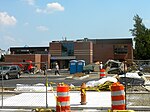Overbrook Elementary School
1914 establishments in PennsylvaniaColonial Revival architecture in PennsylvaniaOverbrook, PhiladelphiaPhiladelphia County, Pennsylvania Registered Historic Place stubsPublic elementary schools in Philadelphia ... and 3 more
School District of PhiladelphiaSchool buildings completed in 1914School buildings on the National Register of Historic Places in Philadelphia

Overbrook Elementary School is a historic elementary school in the Overbrook neighborhood of Philadelphia, Pennsylvania. It is part of the School District of Philadelphia. The building was built in 1905–1907, and is a two-story, nine-bay brick building faced with granite in the Colonial Revival-style. It sits on a raised basement. An eight-bay addition designed by Henry deCourcy Richards was built in 1913–1914. It features a slightly projecting front gable.The building was added to the National Register of Historic Places in 1988.
Excerpt from the Wikipedia article Overbrook Elementary School (License: CC BY-SA 3.0, Authors, Images).Overbrook Elementary School
North 62nd Street, Philadelphia
Geographical coordinates (GPS) Address Nearby Places Show on map
Geographical coordinates (GPS)
| Latitude | Longitude |
|---|---|
| N 39.9819 ° | E -75.2456 ° |
Address
Overbrook Elementary School
North 62nd Street
19151 Philadelphia
Pennsylvania, United States
Open on Google Maps








